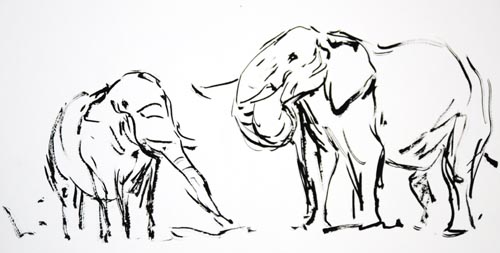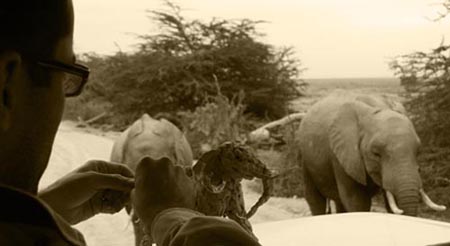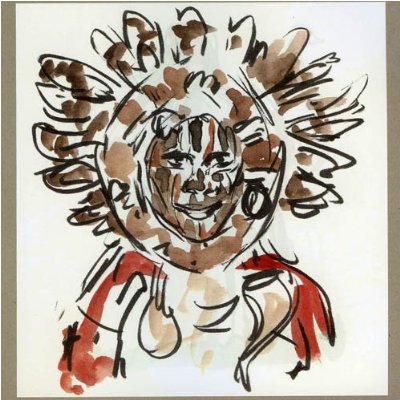Originally posted by Grrlscientist
On February 27, 2009, at 12:53 PM
 I love art, birds and travel, and because Africa has such a huge variety of exotic wildlife that I've only ever seen in zoos and aviaries, it is high on my list of places to visit. Recently, David G. Derrick, Jr., the author of a new book that combines art and African wildlife into an unusual diary format, asked if I would like to read and review his new book, African Diaries: Sketches & Observations (self-published, 2008).
I love art, birds and travel, and because Africa has such a huge variety of exotic wildlife that I've only ever seen in zoos and aviaries, it is high on my list of places to visit. Recently, David G. Derrick, Jr., the author of a new book that combines art and African wildlife into an unusual diary format, asked if I would like to read and review his new book, African Diaries: Sketches & Observations (self-published, 2008).
This slim paperback is an unusual travel diary because it is comprised of more than 140 of hand-drawn pictures of people and animals, along with accompanying photographs and hand0written notes, all created while the author was traveling through Kenya, Africa.
The book opens with a hand drawn map of Kenya that shows the route that Derrick followed during his visit in the summer of 2008. On the facing page are his first diary entries detailing of the aircraft he flew in on, along with an excited note that the first wildlife that he saw were two African crowned cranes. He also records the smells of Kenya and even takes a moment to wonder if his luggage arrived.
The book is divided into sections defined by the stops along the author's route or by the animal species that he found particularly fascinating. Each section is filled with sketches and notes documenting Derrick's observations of the birds and wildlife, people and landscapes he found along his travels. His journey begins in the capital, Nairobi, which is characterized by a curious juxtaposition of the old (donkeys pulling carts) and the new (cell phones). After spending time in the nearby Nairobi National Park and giraffe watching in Giraffe Manor, Derrick moves on to Amboseli National Park, where he becomes enamored by a group of nomadic Maasai, a number of whom he ended up drawing, and by wild elephants, whose skin changes hue depending upon their surroundings. He was so impressed by the elephants that, while in the field, Derrick creates a bronze sculpture of a large and very distinctive bull elephant (below), and the final product is pictured in the book. This sculpture was later the victim of a vervet monkey who bit one of the ears off when searching the author's belongings for food.
But the wildlife that the author documents was not limited to just the Amboseli elephants. The author also devotes pages to documenting rhino, giraffe, cheetahs, lion and hyena behaviors; observations of an agama sitting on a sun-bleached hippo skull; huge herds of Grant's and Thomson's gazelles, zebra and wildebeast, more commonly known by the onomatopoeic Swahili name, gnu (pictured below); cape buffalo, warthogs, marabou storks (pictured bottom) and other animals.
One particularly affecting series of images were those that documented a male lion with a kill. The author wrote in his sketch book; "We were so close to the lion that I could hear bones crunch and flesh tear. Being so close for the first time to a large male lion my heart was pounding and adrenaline running. Fortunately I was able to calm my nerves enough to dash off these sketches."
But my favorite individual pictures were a black-on-white painting of a lone red-billed hornbill, 16 pages from the end of the book and the black-on-white painting of a Go-Away Bird (unfortunately, I could not find these particular images to share with you).
But Derrick recognizes that Africa is not a paradise; there are plenty of hidden dangers as well. During his travels, the author meet and draws some of the native peoples of Kenya, and mentions a massacre that occurred in the Nakuru district a few months prior to his visit.
Overall, this book is a rare combination of a field trip narrative with art and science. The drawings, paintings and photographs provide the sense that you are there experiencing these events alongside the author, seeing the animals and the people through his eyes. Even though this is a paperback, it is printed on heavy paper and the images are of high enough quality that you can actually see the grain of the paper upon which the sketches and paintings were originally created. If you are a fan of Africa, its wildlife and native peoples, or if you are attracted by the synergy between art and science, then you will enjoy this book.
David Derrick is a professional artist and author who studied fine arts at the University of Utah and at the California Institute of the Arts. While he was still a student, his films attracted a lot of recognition, including a student Emmy Award. He has since worked on many big budget Hollywood films including Bee Movie, Over the Hedge, Flushed Away and is currently helping create the sequel to Kung Fu Panda. He previously published Kadogo The Next Big Thing (Dark Horse, 2008) and Scrambled Ink (Dark Horse, 2008). African Diaries is his third book. Derrick works for DreamWorks Animation and lives in the Los Angeles area.
- Log in to post comments





thanks..